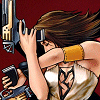
When you’re a woman in any industry, you have to deal with unspoken expectations of what to wear and, in some cases, how to “act.” Yes, there is bias and yes, it’s part of culture. To say that bad gender treatment doesn’t exist, means that you probably haven’t experienced it or even recognized it for what that means. But, like racism or homophobia or Islamaphobia, it’s there and it’s tough to talk about. Today I’m going to share my thoughts on the image of women and video games.
Some of the “day jobs” I had over the years didn’t understand my love of gaming. Co-workers begged me not to tell anyone that they, too, liked to play Halo or Final Fantasy because they were afraid of how other people would treat them. After all, kids play these games, too. So that automatically means women who play games must be immature, right? My best friend and I made it a point to get to know the clerks at video game stores in town, just so we wouldn’t have to deal with the assumption that we were buying for our boyfriend/husband/nephew/etc. Last time I bought a game at a store, one clerk said: “This is Arkham City. You know that’s not for kids, right?” The guy standing next to him said: “Well, I should hope so! She’s playing it!” If you don’t think this attitude is pervasive, read: WTF is with empowered women? The description of the women who play games is… Oy…
So yes, there’s a stereotype that women who play games are fugly and will only buy games if the women are “empowered.” Here’s a little newsflash for you: I like empowered female characters because as a woman? That’s how I view women are supposed to be portrayed in a game that is marketed/designed/sold for all genders. Do you really think I want to play a game where women are treated like painted cattle? What the hell is a woman supposed to be like if her character can’t stand on her own, anyway? We’re not doormats!
Women gamers have always been around, but many (including myself) have felt we had to hide because we knew it was a man’s industry. Remember Chuck E. Cheese’s and the arcades? Before RPG-style games, much of the 8-bit versions were less gender-specific and more character-driven. Pac-Man and Ms. Pac-Man are not shapely by any stretch of the imagination. I was a big Metroid fan and really liked the old Donkey Kong and Donkey Kong, Jr. Sure, I rolled my eyes at some parts in Super Mario Brothers, but at no point did I say: “Gee, I wish I was playing Maria and Louisa to rescue Prince Mango.” It was part of the game. I smushed mushrooms. I got gold. I punched my fist through a brick. End of story.
Enter the controversial titles and the explosion of the hobby. Doom was the first WTF title I encountered, but there were others. Wikipedia has a List of Controversial Video Games you can check out. Notice how the list gets bigger as time goes on? That’s what popularity does to any business. There’s the good, there’s the bad, and there’s the ugly.
Anonymity and the internet has changed “women in gaming” attitudes because it’s allowed us to buy games from the comfort of our laptops and not deal with the b.s. (Same goes for comics, too.) We aren’t as intimidated because as time went on? It’s become more acceptable for us to play games openly without worrying about how we’ll be treated. In my experience, the hobby games industry — Magic: the Gathering, Munchkin, Vampire: the Masquerade and Vampire: the Requiem, etc. — has been more welcoming toward women than the video games industry traditionally has. This, however, is also changing because MMOs are more popular and creative people are tapping into that community with properties like The Guild.
But — and this is the point I’m trying to make — the “image” exists because it’s a cultural stereotype that women need to look and act a certain way. How women are portrayed ties into cultural attitudes and it’s the game designer’s responsibility to figure out a) who will buy this game and b) how can they create it to appeal to that audience. I feel that gender portrayal is part of world building. When I played Dragon Age my first time through, I picked a female character named Aliessia who had a big, damn sword. “Well, you don’t see many female warriors around.” was part of the dialogue and I appreciated that. Her role in that society affected how she was treated in some cases but it did not break the game.
I’ll be the first one to say that I can’t stand Grand Theft Auto. Does that mean it should never have been created? No, it just means that I won’t buy it. Artistically, I can’t make the claim that ALL women should be portrayed a certain way and ALL games should do “X.” That will never happen because not all designers are the same and not all gamers are the same. Sometimes, controversy makes us think about what makes a “good” game and what isn’t. Other times, it’s not the game that’s the problem, it’s the marketing or it’s specific cut scenes. I love Lara Croft as a property, but I can’t stand the boob physics. I had to physically put down Bloodrayne because the main character feeds by humping her victims and showing off her… Well… Mind you, vampires are my deal creatively so seeing her hop on like a frog made me laugh and then chuck the controller.
I love to have fun! I used to go dancing and clubbing but that type of social life is exhausting and counter-productive for me. Gaming allows me to catch a mental break after an intense day at work or when I’m writing. I play all kinds of games — video, card, board, RPG, whatever — and it’s no secret that gaming is good for you and games prevent Alzheimer’s. I tend not to play Bejeweled anymore because it feels like gambling to me and it’s too repetitive.
What I *don’t* love, is this idea that the fantasy of what a woman (or man) should look like must become a reality. That image is such a problem average-sized women are often considered “Plus Size.” Houston: this is not a video game problem, this is much bigger than that. You can read Plus Size Bodies, What is Wrong With Them Anyway? or, for a laugh, watch this Adobe Photostop Parody.
In my opinion, the growing popularity of video games is a good thing. To affect change, players have to vote with our dollars and get into the industry on a creative level. To put our foot down with how women are generally portrayed? Well, that’s another blog post for another time.
- [Insert Life Bits Here.] This week, my life “bits” that you normally receive are on hold. (Get your mind out of the gutter…) I am away on business and, in anticipation of a thrilling but busy week, have written this post in advance. I’ll be back soon, though! Comments are moderated, but I’ll get to them when I can.



2 Responses to On Women in Video Games